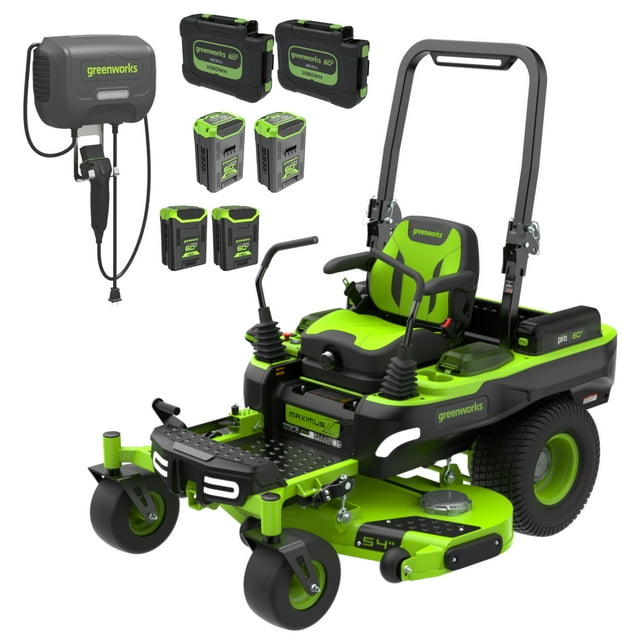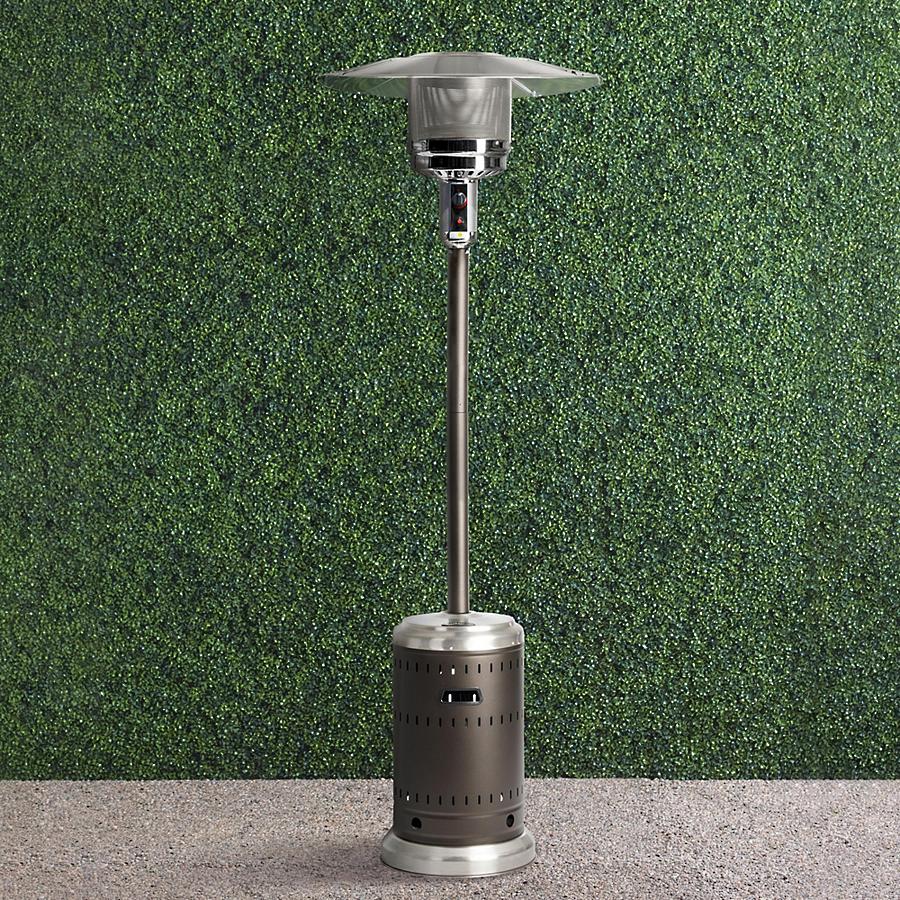Greenworks 60V 54″ MaximusZ Zero Turn Riding Mower with (2) 20.0 Ah, (2) 8.0 Ah & (2) 4.0 Ah Batteries and 1.5kW Charger 7422302
New Greenworks 60V 54″ MaximusZ Zero Turn Riding Mower. Cuts up to 3.5 acres on a single charge with included batteries. 31 HP gas-powered engine equivalent with intelligent brushless motor technology vs gas-powered competitors.
Quickly mow up to 3.5 acres on a single charge, then fully recharge batteries in less than 3.5 hours with the Greenworks 60V 54” 31 HP Electric Battery-Powered MaximusZ Zero-Turn Riding Lawn Mower, with (2) 20.0 Ah, (2) 8.0 Ah & (2) 4.0 Ah Batteries and 1.5 Kw Charger. Never bog down in tall, thick, or wet grass, thanks to triple-cutting blade motors. Feel the unmatched power with zero-turn lap bar steering and two high-torque brushless hub motors that mow at speeds up to 8 MPH. Greenworks unrivaled Intelligent Power combines brushless motor technology, cutting, drive, control, and battery systems to sense and auto-adapt power for the job at hand with a power output equivalent to a 31 HP gas-powered motor. Includes (2) 20.0 Ah, (2) 8.0 Ah & (2) 4.0 Ah Batteries and 1.5Kw Charger. Battery is compatible with 75+ Greenworks 60V products.
- New Greenworks 60V 54″ MaximusZ Zero Turn Riding Mower:
- Cuts up to 3.5 acres on a single charge with included batteries
- 31 HP gas-powered engine equivalent with intelligent brushless motor technology vs gas-powered competitors
- Ultra-fast charging in 3.5 hours
- Cutting speeds up to 8 MPH to get the job done faster and give you time back in your day vs gas-powered competitors
- Three high-torque brushless hub blade motors provide a constant 17K FPM blade tip speed for optimal power and various grass conditions
- Innovative bog-resistant SmartCutTM Technology auto-adapts to grass conditions for the perfect cut vs gas-powered competitors
- 14-position cutting height adjustment with a single lever to achieve the perfect cut height; Cutting height adjustments: 1.5” – 4.5”
- Industry’s only zero-turn mower with an intergraded utility dump bed hauls up to 200 lbs. of cargo, and tow capacity of 300 lbs
- Easily handles slopes up to 15° with adaptive traction control to keep mower straight on slopes and prevent sliding on hills
- Adjustable suspension seat with lumbar support and fold-down armrests for added comfort
- High-intensity LED illumination headlight to safely work in low light conditions
- 54” heavy-duty 10-gauge fabricated steel deck provides maximum airflow for optimal cutting and side discharge
- Front-mount 2” receiver hitch for mower accessories to multi-purpose your machine
- Rear-hitch is capable of towing up to 300 lbs. to haul trailers and pull-behind attachments
- On-board USB B (Type A, Type C) charging ports and two cup holders for maximum operator convenience
- 60V battery powers over 75+ products; One battery to mow, blow, cut, trim, cultivate, and more
- 4-year tool and battery limited warranty
Additional information
| Horsepower | 32 Horsepower |
|---|---|
| Outdoor Equipment Propulsion Method | All Wheel Drive |
| Power Type | Battery |
| Manufacturer Part Number | 7422302 |
| Cutting Width | 54 in |
| Volts | 60 V |
| Contained Battery Type | Lithium Ion |
| Assembled Product Dimensions (L x W x H) | 86.61 x 62.00 x 34.25 Inches |
0 (zero) is a number representing an empty quantity. Adding 0 to any number leaves that number unchanged. In mathematical terminology, 0 is the additive identity of the integers, rational numbers, real numbers, and complex numbers, as well as other algebraic structures. Multiplying any number by 0 has the result 0, and consequently, division by zero has no meaning in arithmetic.
As a numerical digit, 0 plays a crucial role in decimal notation: it indicates that the power of ten corresponding to the place containing a 0 does not contribute to the total. For example, "205" in decimal means two hundreds, no tens, and five ones. The same principle applies in place-value notations that uses a base other than ten, such as binary and hexadecimal. The modern use of 0 in this manner derives from Indian mathematics that was transmitted to Europe via medieval Islamic mathematicians and popularized by Fibonacci. It was independently used by the Maya.
Common names for the number 0 in English include zero, nought, naught (), and nil. In contexts where at least one adjacent digit distinguishes it from the letter O, the number is sometimes pronounced as oh or o (). Informal or slang terms for 0 include zilch and zip. Historically, ought, aught (), and cipher have also been used.
1 (one, unit, unity) is a number representing a single or the only entity. 1 is also a numerical digit and represents a single unit of counting or measurement. For example, a line segment of unit length is a line segment of length 1. In conventions of sign where zero is considered neither positive nor negative, 1 is the first and smallest positive integer. It is also sometimes considered the first of the infinite sequence of natural numbers, followed by 2, although by other definitions 1 is the second natural number, following 0.
The fundamental mathematical property of 1 is to be a multiplicative identity, meaning that any number multiplied by 1 equals the same number. Most if not all properties of 1 can be deduced from this. In advanced mathematics, a multiplicative identity is often denoted 1, even if it is not a number. 1 is by convention not considered a prime number; this was not universally accepted until the mid-20th century. Additionally, 1 is the smallest possible difference between two distinct natural numbers.
The unique mathematical properties of the number have led to its unique uses in other fields, ranging from science to sports. It commonly denotes the first, leading, or top thing in a group.
2 (two) is a number, numeral and digit. It is the natural number following 1 and preceding 3. It is the smallest and only even prime number. Because it forms the basis of a duality, it has religious and spiritual significance in many cultures.
Twenty or 20 may refer to:
- 20 (number), the natural number following 19 and preceding 21
- one of the years 20 BC, AD 20, 1920, 2020
4 (four) is a number, numeral and digit. It is the natural number following 3 and preceding 5. It is a square number, the smallest semiprime and composite number, and is considered unlucky in many East Asian cultures.
54 may refer to:
- 54 (number)
- one of the years 54 BC, AD 54, 1954, 2054
- 54 (novel), a 2002 novel by Wu Ming
- Studio 54, a New York City nightclub from 1977 until 1981
- Fifty-Four (film), a 1998 American drama film about the club
- 54 (album), a 2010 album by Metropole Orkest
- "Fifty Four", a song by Karma to Burn from the album Arch Stanton, 2014
- 54th Division (disambiguation)
- 54th Regiment of Foot (disambiguation)
- 54th Infantry (disambiguation)
- 54 Alexandra, a main-belt asteroid
Charger or Chargers may refer to:
- Charger (table setting), decorative plates used to fancify a place setting
- Battery charger, a device used to put energy into a cell or battery
- Capacitor charger, typically a high voltage DC power supply designed to rapidly charge a bank of capacitors in pulsed power applications
- Whipped-cream charger, a cartridge designed to deliver nitrous oxide in a whipped cream dispenser
- Charger (firearm), a common and chiefly British term for a stripper clip, used in the reloading of firearms
- A war horse
- A type of special infected in Left 4 Dead 2
- The squadron name for US Navy Strike Fighter Squadron VFA-161
- USS Charger
- HMS Charger
A mower is a person or machine that cuts (mows) grass or other plants that grow on the ground. Usually mowing is distinguished from reaping, which uses similar implements, but is the traditional term for harvesting grain crops, e.g. with reapers and combines.
A smaller mower used for lawns and sports grounds (playing fields) is called a lawn mower or grounds mower, which is often self-powered, or may also be small enough to be pushed by the operator. Grounds mowers have reel or rotary cutters. Larger mowers or mower-conditioners are mainly used to cut grass (or other crops) for hay or silage and often place the cut material into rows, which are referred to as windrows. Swathers (or windrowers) are also used to cut grass (and grain crops). Prior to the invention and adoption of mechanized mowers, (and today in places where use a mower is impractical or uneconomical), grass and grain crops were cut by hand using scythes or sickles.
To turn is to rotate, either continuously like a wheel turns on its axle, or in a finite motion changing an object's orientation. Turn may also refer to:
With or WITH may refer to:
- With, a preposition in English
- Carl Johannes With (1877–1923), Danish doctor and arachnologist
- With (character), a character in D. N. Angel
- With (novel), a novel by Donald Harrington
- With (album), a 2014 album by TVXQ
- With (EP), a 2021 EP by Nam Woo-hyun






Reviews
There are no reviews yet.